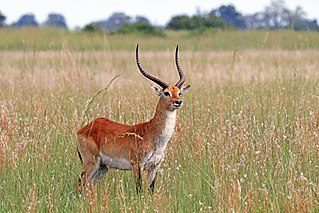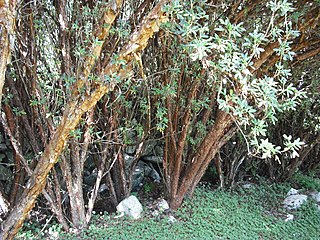
The International Union for Conservation of Nature (IUCN) Red List of Threatened Species, founded in 1964, is the world's most comprehensive inventory of the global conservation status of biological species. It uses a set of precise criteria to evaluate the extinction risk of thousands of species and subspecies. These criteria are relevant to all species and all regions of the world. With its strong scientific base, the IUCN Red List is recognized as the most authoritative guide to the status of biological diversity. A series of Regional Red Lists are produced by countries or organizations, which assess the risk of extinction to species within a political management unit.

The hartebeest, also known as kongoni, is an African antelope. It is the only member of the genus Alcelaphus. Eight subspecies have been described, including two sometimes considered to be independent species. A large antelope, the hartebeest stands just over 1 m (3.3 ft) at the shoulder, and has a typical head-and-body length of 200 to 250 cm. The weight ranges from 100 to 200 kg. It has a particularly elongated forehead and oddly shaped horns, short neck, and pointed ears. Its legs, which often have black markings, are unusually long. The coat is generally short and shiny. Coat colour varies by the subspecies, from the sandy brown of the western hartebeest to the chocolate brown of the Swayne's hartebeest. Both sexes of all subspecies have horns, with those of females being more slender. Horns can reach lengths of 45–70 cm (18–28 in). Apart from its long face, the large chest and the sharply sloping back differentiate the hartebeest from other antelopes.

Lichtenstein's hartebeest is a subspecies of the hartebeest antelope that dwells in savannahs and floodplains of Southeastern-Central Africa. It is sometimes classified as a unique species Sigmoceros lichtensteinii.

The lechwe, red lechwe or southern lechwe, is an antelope found in wetlands of south central Africa.

The Cape shoveler or Cape shoveller is a species of dabbling duck of the genus Spatula. It is resident in South Africa, and uncommon further north in Namibia, Botswana, Zimbabwe, southern Angola, Lesotho, Mozambique, and Zambia.

Solanum elaeagnifolium, the silverleaf nightshade or silver-leaved nightshade, is a common naive plant to parts of the southwestern USA, and sometimes weed of western North America and also found in South America. Other common names include prairie berry, silverleaf nettle, white horsenettle or silver nightshade. In South Africa it is known as silver-leaf bitter-apple or satansbos. More ambiguous names include "bull-nettle", "horsenettle" and the Spanish "trompillo". The plant is also endemic to the Middle East.

Ancistroteuthis lichtensteinii, also known as the angel clubhook squid or simply angel squid, is a species of squid in the family Onychoteuthidae and the sole member of the genus Ancistroteuthis. It grows to a mantle length of 30 cm. It can be found in the western Mediterranean Sea, subtropical and tropical eastern Atlantic Ocean and western north Atlantic Ocean. Its diet include mesopelagic fish and pelagic crustaceans. It is sometimes taken as bycatch by commercial fisheries, but is not a targeted species.

Lichtenstein's sandgrouse is a species of bird in the Pteroclidae family, which is named after Martin Lichtenstein. They are nomadic, mostly nocturnal birds, which drink before dawn and after dusk.
The rock dormouse or flat-headed African dormouse is a species of rodent in the family Gliridae. It is found in Botswana, Mozambique, South Africa, Eswatini, Zambia, and Zimbabwe where it lives among rocks in upland areas. It is a fairly common, mainly nocturnal species and the International Union for Conservation of Nature has assessed its conservation status as being of "least concern".

Polylepis racemosa is a species of small tree in the family Rosaceae. It is endemic to Peru, Bolivia, and Ecuador. It is threatened by habitat destruction. The International Union for Conservation of Nature has assessed the conservation status of this tree as "vulnerable".
Solanum sodiroi is a species of plant in the family Solanaceae. It is possibly endemic to Ecuador.

Solanum granuloso-leprosum is a species of plant in the family Solanaceae.
Solanum pseudoquina is a species of plant in the family Solanaceae. It is endemic to Brazil. A rare plant, it is dependent on conservation of its habitat to prevent it from becoming a threatened species.
Solanum luteoalbum is a species of plant in the family Solanaceae.
Solanum ternatum is a species of plant in the family Solanaceae. Its natural habitat is subtropical or tropical moist montane forests.
Wiesneria is a genus in the family Alismataceae. The plant usually lives in natural temporary water pools on lateritic plateaus. Wiesneria triandra was first described in the south of the Indian state of Maharashtra. They are well spread out over the regions they occupy and have no common uses, making them of least concern.

A not evaluated (NE) species is one which has been categorized under the IUCN Red List of threatened species as not yet having been assessed by the International Union for Conservation of Nature.
Andromonoecy is a breeding system of plant species in which male and hermaphrodite flowers are on the same plant. It is a monomorphic sexual system alongside monoecy, gynomonoecy and trimonoecy. Andromonoecy is frequent among genera with zygomorphic flowers, however it is overall rare and occurs in less than 2% of plant species. This breeding system has gained interest among biologists in the study of sex expression.

Tarphius floresensis is a beetle species in the family Zopheridae endemic to Flores Island (Azores). It is commonly named as an iron-clad beetle in English or Escaravelho-cascudo-da-mata in Portuguese. The genus Tarphius is evolutionarily old species to Azores.
Solanum rigidum is a species of plant in the family Solanaceae. It goes by the common names olho de vaca or olho de boi.











